
By Keith Schneider, Circle of Blue
The Great Lakes News Collaborative includes Bridge Michigan; Circle of Blue; Great Lakes Now at Detroit Public Television; and Michigan Radio, Michigan’s NPR News Leader; who work together to bring audiences news and information about the impact of climate change, pollution, and aging infrastructure on the Great Lakes and drinking water. This independent journalism is supported by the Charles Stewart Mott Foundation. Find all the work HERE.
Third of a six-part series. Read the first story here.
ADRIAN, Mich. – Tom Van Wagner has a vision for what’s possible in Lenawee County for choking off phosphorus discharges from farm fields. A career specialist in soils and forestry health, most of it with the Natural Resource Conservation Service, a unit of the U.S. Department of Agriculture, Van Wagner has spent 38 years in Lenawee County promoting environmentally sensitive nutrient management and cultivation practices.
His message: Row crop farmers can substantially reduce phosphorus fertilizer use. Across much of the county’s farmland they don’t need it at all to produce ample yields. Livestock producers, he says, have soil testing and more sensitive manure spreading equipment that, if they really paid attention, would enable them to apply liquid manure much more carefully.
“There’s so much latent phosphorus in the soil from over fertilization,” Van Wagner said. “Farmers are spending a lot of money on nutrients. They don’t need it. They’re over fertilizing.”
It’s a tough sell. Production is a top priority. Profit margins are tight for all agriculture operations — dairies, hog facilities, and crop farmers. The investments farmers make in equipment and nutrient application are baked into crop and livestock systems. And though federal financial support is available, change is expensive. Just as important is the storied independence of farmers, their suspicion of new messages and outsiders, their intransigence. Most farmers have not climbed aboard.
“I’ve said we need a generational change,” Van Wagner jokes. “I say it because some of the old producers have been doing this a long time and they aren’t going to change.”

Tom Van Wagner, a soils and forestry specialist in Lenawee County, promotes cultivation practices to sharply reduce phosphorus applications in farm fields. Photo © J. Carl Ganter/ Circle of Blue
A Weakened National Imperative
A principal reason farmers won’t is because they don’t have to. Fifty years ago the Great Lakes Water Quality Agreement was signed and the Clean Water Act was enacted to clear pollution from the region’s waters. Both the bi-national agreement and the U.S. clean water statute, though, give farmers and their wastes special treatment. They ask little more than that producers voluntarily take responsibility for the sharp increases in the level of nutrients pouring off of farm fields.
The reason is that the authors of the Great Lakes Water Quality Agreement and the Clean Water Act never anticipated the effect on farms, farmland, and contemporary production practices from a third crucial piece of legislation – the U.S. Farm Bill. Initially enacted in 1933 and now reauthorized roughly every five years, it’s had the same transformative influence on American agriculture as the 1956 Interstate Highway Act has had for emptying U.S. cities, filling suburbs, and changing the American economy and lifestyle. Since the Farm Bill’s initial passage, 4.8 million farms have gone out of business, a 70 percent drop. Efficiency and productivity became the watchwords of U.S. agriculture.
Every farm sector is affected. The typical commercial row crop farm is over 1,000 acres. Livestock operations manage thousands of animals indoors, no longer free to graze in pastures. The 1,300 farms in Lenawee County, the 47,500 farms in Michigan, and the two million farms across the U.S. are the frontline of an immense $1.1 trillion American food and fiber production sector that counts powerful allies in marketing, equipment, chemical, energy industries, and politics.
The productivity of U.S. agriculture is the envy of the world. But American farms also are responsible for dire cultural, health, and environmental consequences that have stirred decades of academic research, journalistic investigation, and civic protest. Pushed by the powerful farm lobby, state and congressional legislators have displayed scant interest in fixing big holes and outright waivers for farms in the federal water quality law. Federal, state, and academic studies show that over the last two generations no watershed where agriculture is dominant — in Michigan, Ohio, or any other Great Lakes state — has voluntary action curbed nutrient runoff. Harmful algal blooms are the result.
Because of the severe consequences of farming to water quality, the golden anniversary of the bi-national agreement and the U.S. clean water statute is a timely lesson in setting ambitious goals that fall treacherously short. A big toxic bloom again this year painted western Lake Erie in swirls of green. In July, the Washtenaw County Health Department issued an advisory warning for the third year in a row for a bloom on Ford Lake in Ypsilanti. Harmful blooms again poison Saginaw Bay, Lake Macatawa, and have emerged in increasing numbers of lakes across Michigan and the Great Lakes region, including largely undeveloped Lake Superior.
How this occurred is a story of law, policy, technology, and public investment that converged to improve Lake Erie’s water quality in the 1970s and 1980s, but began to falter starting in the late 1990s.
It’s also a story of phosphorus, a mineral essential at trace levels to the growth of every living thing on earth. Discovered in 1669, it was added to the periodic table of elements in 1869. Encouraged by recommendations from agricultural universities, American farmers spent much of the last century over-applying phosphorus fertilizer to push the production of their crops ever higher. That agronomic guidance was supported by the nearly $20 billion American fertilizer industry, which mines over 30 million tons of phosphate rock a year, most of it in Florida, and turns it into 4 millions of tons of pelletized commercial diammonium phosphate that is spread on fields. Because of the heavy influence of soybean and corn production, Great Lakes and Midwest farmers use more phosphate fertilizer than in any other region of the country.
Phosphorus also is a constituent in the manure that big livestock operations turn to liquid and spread on fields. And as the number of big livestock operations increases in the region, so does the amount of phosphorus.
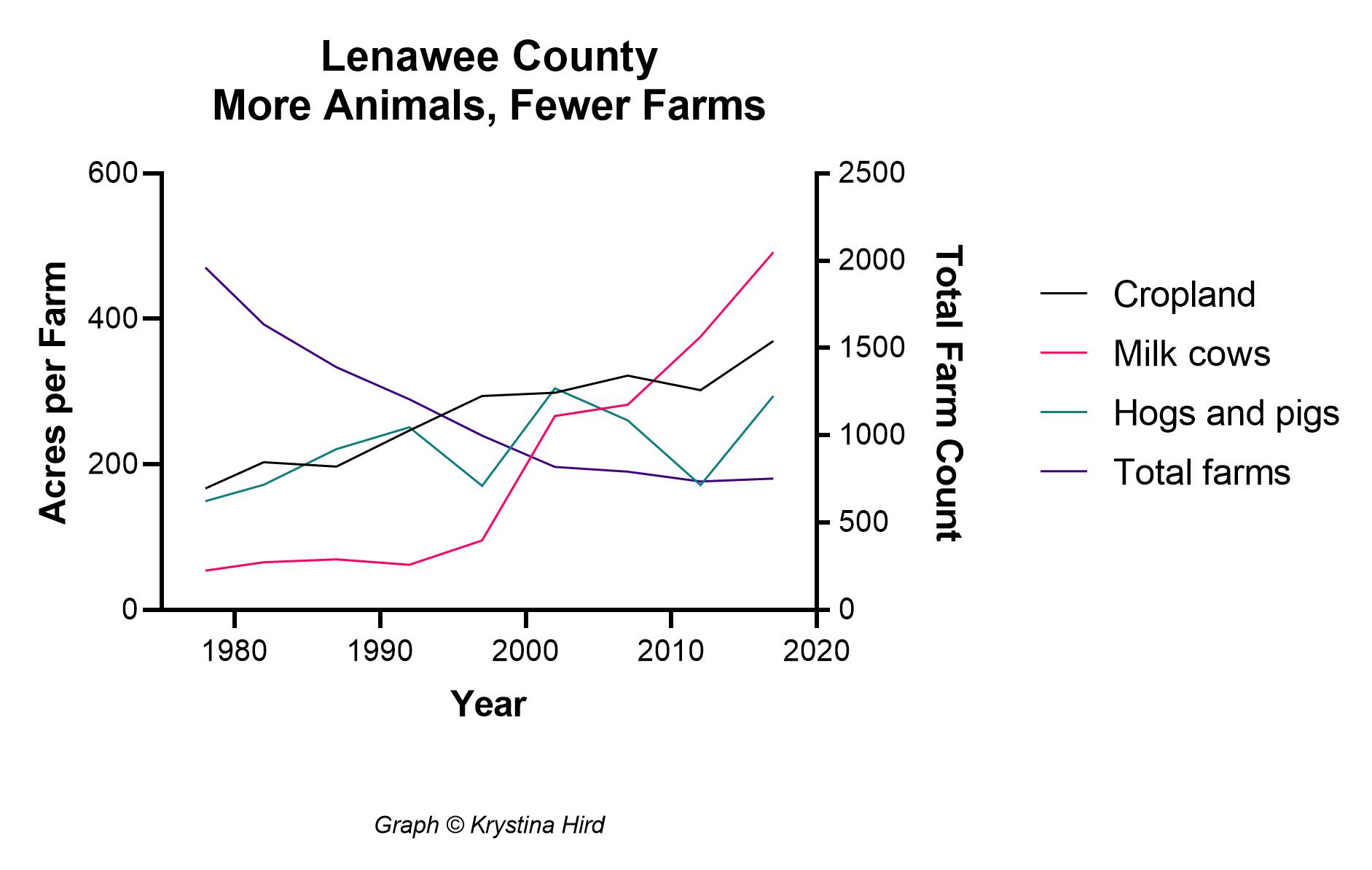
https://agcensus.library.cornell.edu/ and https://www.nass.usda.gov/Publications/AgCensus/2017/Full_Report/Volume_1,_Chapter_1_US/
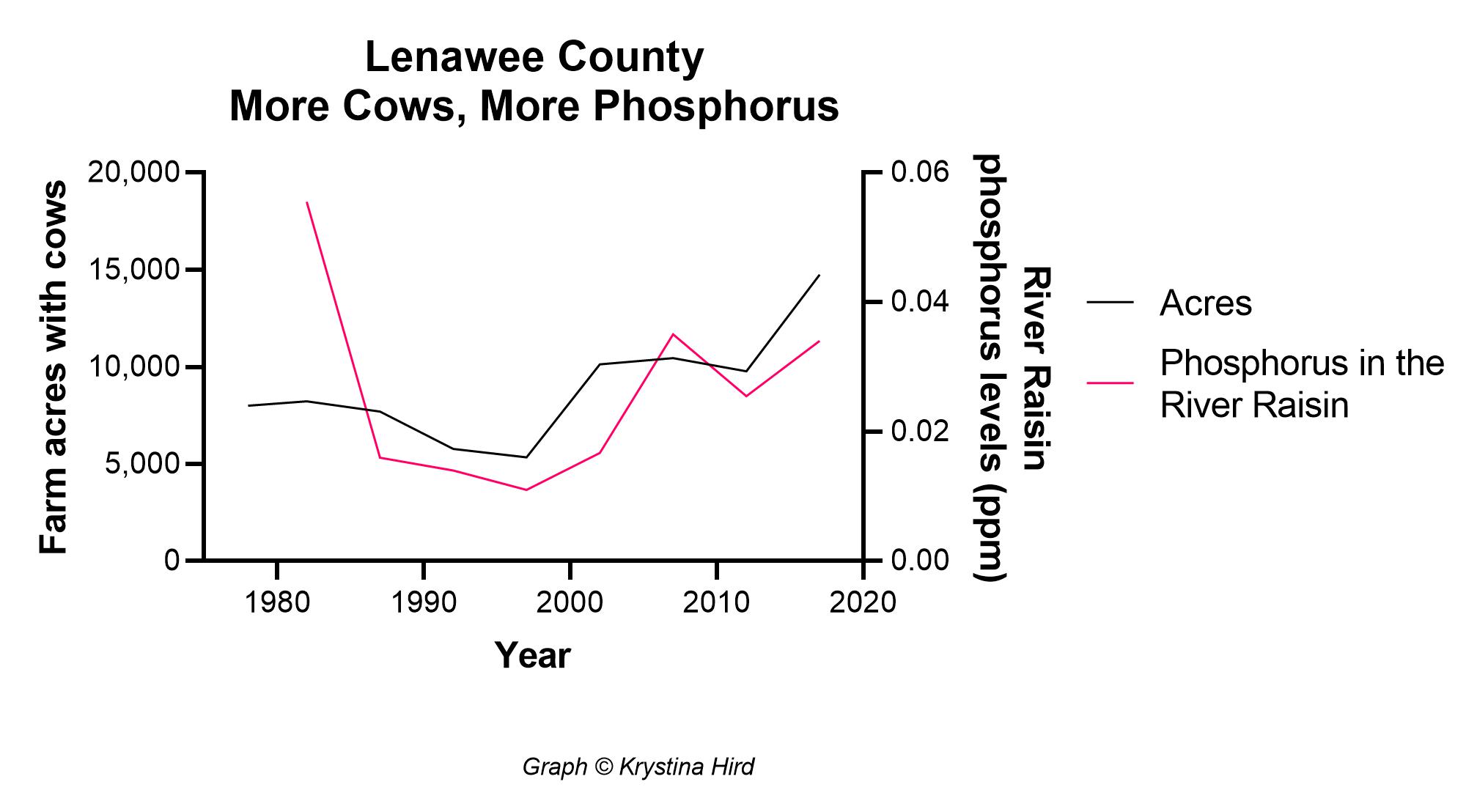
U.S. Department of Agriculture 2017 Census and U.S. Department of Agriculture Publications and National Center for Water Quality, Heidelberg University
A last point. Only a scant amount of phosphorus – an extra few hundredths of a part per million concentration in water — is required in streams and lakes to encourage the growth of toxic algae. Farm associations assert that because the price of phosphorus fertilizer rose from $480 a ton in December 2020 to about $826 a ton in November 2021, crop farmers are using less.
But even if farmers cut applications, it does not necessarily mean less phosphorus is draining into water. When phosphorus is added to soils, just 15 to 30 percent is taken up by crops. Some of what’s left can be trapped by soil particles. Decades of fertilizer over-application has left legacy phosphorus in soil. Phosphorus not taken up by plants or absorbed in soil dissolves into reactive phosphorus, the form favored by cyanobacteria that produce toxic blooms. It’s like pouring water on a saturated sponge. Pushed by heavy rains, excess phosphorus dissolves into soluble phosphorus that drains away in the region’s subsurface tile networks, and out into ditches and streams.

Blaine Baker and his brother, Kim, own and operate Bakerlads Farm and are known as early adopters of farm practices meant to increase profits and temper environmental risks. Photo © J. Carl Ganter/ Circle of Blue
A Path Forward?
The crucial step in the region-wide recipe for ending harmful blooms is pretty straightforward: drastically reduce the amount of phosphorus reaching open waters. As a respected farm specialist with so many allies that he was named chairman of the Lenawee County Farm Bureau, Tom Van Wagner is spending the latter years of his career trying to do just that.
Among the farmers who have turned to him for technical assistance and psychic support are Blaine Baker, who with his brother Kim manages 560 dairy cows, an equal number of replacements, plus 2,500 acres of corn, soybeans, and alfalfa on Bakerlads Farm, west of Adrian. Not far away, Tim Stutzman, another conservation-minded farmer, feeds cattle and farms 2,800 acres in Morenci.
Like Van Wagner, the two farmers are in their 60s, spent their careers expanding family farms that are generations old, and are known in the Lenawee County farm community as early adopters of farm practices meant to increase profitability and try to temper environmental risks.
All three also are pushing a big barge of needed change upstream. Every step of the way they encounter suspicion from other farmers not interested in environmental safeguards. They also attract criticism from environmental advocates for their roles as leaders of the county chapter of the Michigan Farm Bureau, which represents big commercial producers and routinely opposes environmental regulation. Van Wagner counters that because of their outsize influence in crop and livestock production, altering cultivation and fertilizer practices at big commercial farms is essential for limiting nutrient discharges from the land.
In 1996, the Baker brothers and Stutzman collaborated with Van Wagner to start the Center For Excellence, which holds an annual field day in August at Bakerlads to introduce a crowd of county farmers to practical marketing ideas and more environmentally sensitive production practices. Ten years ago, field day presentations began to focus on fertilizer, manure application, and techniques to impede phosphorus draining from farmland.
As managers of livestock operations, Baker and Stutzman have experience with the principle, advocated by Wagner, that applying less phosphorus saves money and doesn’t necessarily lower yields or harvests. Stutzman spreads manure from his cattle operation and liquid manure delivered from neighboring farms. He relies on a manure management plan that takes into account weather, soil, and crop conditions. He has invested in precision farming technologies that rely on remote sensing and multispectral imagery to cut the farm’s commercial fertilizer use.
The technology measures plant growth and soil conditions. It enables him to spread commercial fertilizer sparingly because the digitized sensors on his equipment apply nutrients to individual plants as needed. His techniques have reduced commercial phosphorus fertilizer use from 120 pounds per acre, which is typical on most farms, to 60 to 80 pounds. On ground where phosphorus concentrations in the soil are above 10 parts per million he does not apply fertilizer.
“There’s farmers here,” Van Wagner said. “You can show them how you save money, you don’t need to apply as much. They’ll tell you it’s a bunch of crap. They tell you it won’t get the crop. They say you got to have phosphorus. I can honestly sit here and say just because you’re low in phosphorus doesn’t mean you’re gonna lose yield.”
Van Wagner also is adept at nutrient management. He and Baker designed a subsurface basin to store two million gallons of liquid waste from the dairy during winter and then release it in spring through a piping network to fertilize and irrigate a 20-acre field. The system was built in 2007 with a $150,000 innovation grant from the USDA.
Baker’s manure management plan calls for applying two million more gallons of liquid manure produced in the spring and summer on hay fields. The subsurface tiling on his farm is a closed loop that directs drainage to an engineered wetland. Surface runoff is managed with 35 sediment control basins that are lined with small stones above drainage tile, and covered with topsoil. He says the systems work well. The closed loop prevents discharge and the stone lining absorbs phosphorus. Three years ago Michigan State University named the Baker brothers Michigan’s Dairy Farmer of the Year.
While Bakerlads Farm is recognized as more careful with its wastes than many CAFO operators, its practices are not foolproof. In 2008, after the subsurface manure storage was installed, Bakerlads was cited by the state Environment Department for a water quality violation for spreading manure on snow covered ground, according to state records compiled by Environmentally Concerned Citizens of South Central Michigan, a local environmental research and advocacy group. The most recent violation was issued in November 2020 for spreading manure within 24 hours of a forecasted heavy rainfall.
“Everything we do is monitored,” Blaine Baker said. “Anytime we’re spreading we’re keeping all sorts of records. Before we spread we look at tile lines. Is it flowing? If it is flowing, is it clear or cloudy? Does it smell? And then when you’re done spreading you have to look at all of that again.
“We’ve had discharges. Once you get a handle on it you pretty well get them taken care of.”
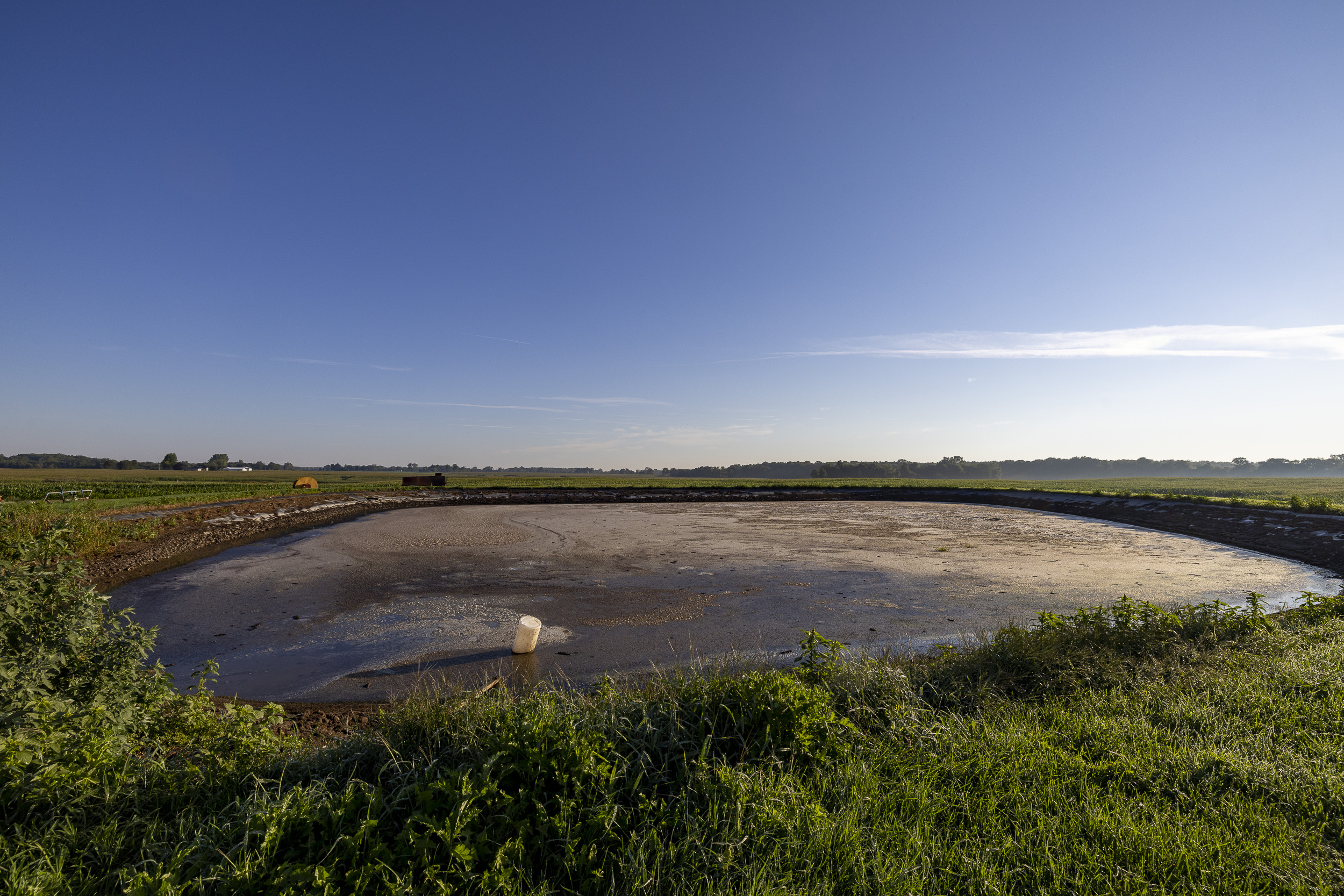
Liquid manure is stored in lagoons like this one in Lenawee County prior to being spread on farmland. Photo © J. Carl Ganter/ Circle of Blue
Regulation Begins
It would be easy to explain the persistence of harmful algal blooms as a systemic reaction to crosscutting law, policy, and practice that seems unsolvable. It’s not. That’s because Canada and the U.S. collaborated once to scrub pollution and clear harmful blooms from the waters of the Great Lakes region.
In April 1972, Canada and the U.S. signed the Great Lakes Water Quality Agreement to share responsibilities for curbing environmental threats and managing one of the largest freshwater ecosystems on earth. The agreement recognized that each country – plus the states and provinces that bounded the five Great Lakes – would have to pass water quality laws. The goal: “Be free from pollutants in quantities or concentrations that could be harmful to human health, wildlife, or aquatic organisms.”
Six months later the U.S. did just that. In October 1972, the U.S. Congress rejected President Richard Nixon’s veto and enacted the Clean Water Act. Administered by the two-year-old Environmental Protection Agency, the statute limited how much nutrient pollution could be discharged by wastewater treatment plants, factories, and other so-called “point source” pollution.
Working in tandem under the Water Quality Agreement, U.S. and Canadian scientists reached consensus on two points. Excessive phosphorus was driving the blooms and dead zones in Lake Erie, and cutting phosphorus loads to Lake Erie from 20,000 tons to 11,000 tons annually, a 45 percent decrease, would end harmful blooms.
Working under the Clean Water Act framework, Congress appropriated more than $101 billion since 1972 on infrastructure to prevent the flow of pollutants into America’s water, including the construction of new and modernized wastewater treatment plants in the Great Lakes region.
Nutrient discharges from cities and industries were cut dramatically. States participated by enacting their own water quality laws. In 1977, for instance, Michigan became the first Great Lakes state to ban phosphates in laundry detergent. The 11,000 ton annual phosphorus target was reached in the mid-1980s. The lake’s condition improved. Harmful algal blooms ended, accomplishing one of the striking public interest successes in American history.
A generation later the big blooms are back. One of the primary causes is a flaw in the Clean Water Act revealed by contemporary farm practices. While providing water quality regulators ample legal tools to stem the flow of “point source” pollutants from cities and industry, Congress limited tools to control “nonpoint” pollution running off the land.
It’s not complete abdication. Regulators have the authority to stem nonpoint pollution in two categories.
They can issue stormwater permits that require builders and communities to solve nonpoint runoff pollution from cities and suburbs. The fixes typically involve repairing stream beds and banks to halt erosion. Cities also can install drainage networks that direct stormwater to ponds to allow sediment to settle or to wetlands that store the runoff and enable plants to absorb nutrients. In many cases projects encompass multi-county and multi-community watersheds, and require residents to collaborate on cleanup plans and the cost of expensive engineering and construction. When the years of planning and execution are completed, such projects are typically very successful.
Detroit, for instance, spent over $1 billion to fix its sewage transport system that overflowed during heavy storms, and $1.2 billion more to upgrade its treatment plant to cut phosphorus discharges. A network of ponds designed to allow sediments to settle, and engineered wetlands to soak up nutrients, is operating now at Western Michigan University in Kalamazoo. It took over a decade to install and cost over $5 million.
The Clean Water Act also directs states to control waste from large concentrated animal feeding operations, or CAFOs. Big dairy, hog, and poultry operations in Michigan and in Ohio must secure a water quality permit and develop a nutrient management plan for disposing manure. But the cultural and political power of the agricultural sector has diminished the capacity of regulators to write effective permits and inspect livestock operations while also taming the zeal for enforcement.
Two years ago Michigan issued a new regulation to strengthen its permit program for spreading CAFO manure. It’s never been put into effect because it’s under attack from the state’s dairy, hog, and poultry associations and the Michigan Farm Bureau.
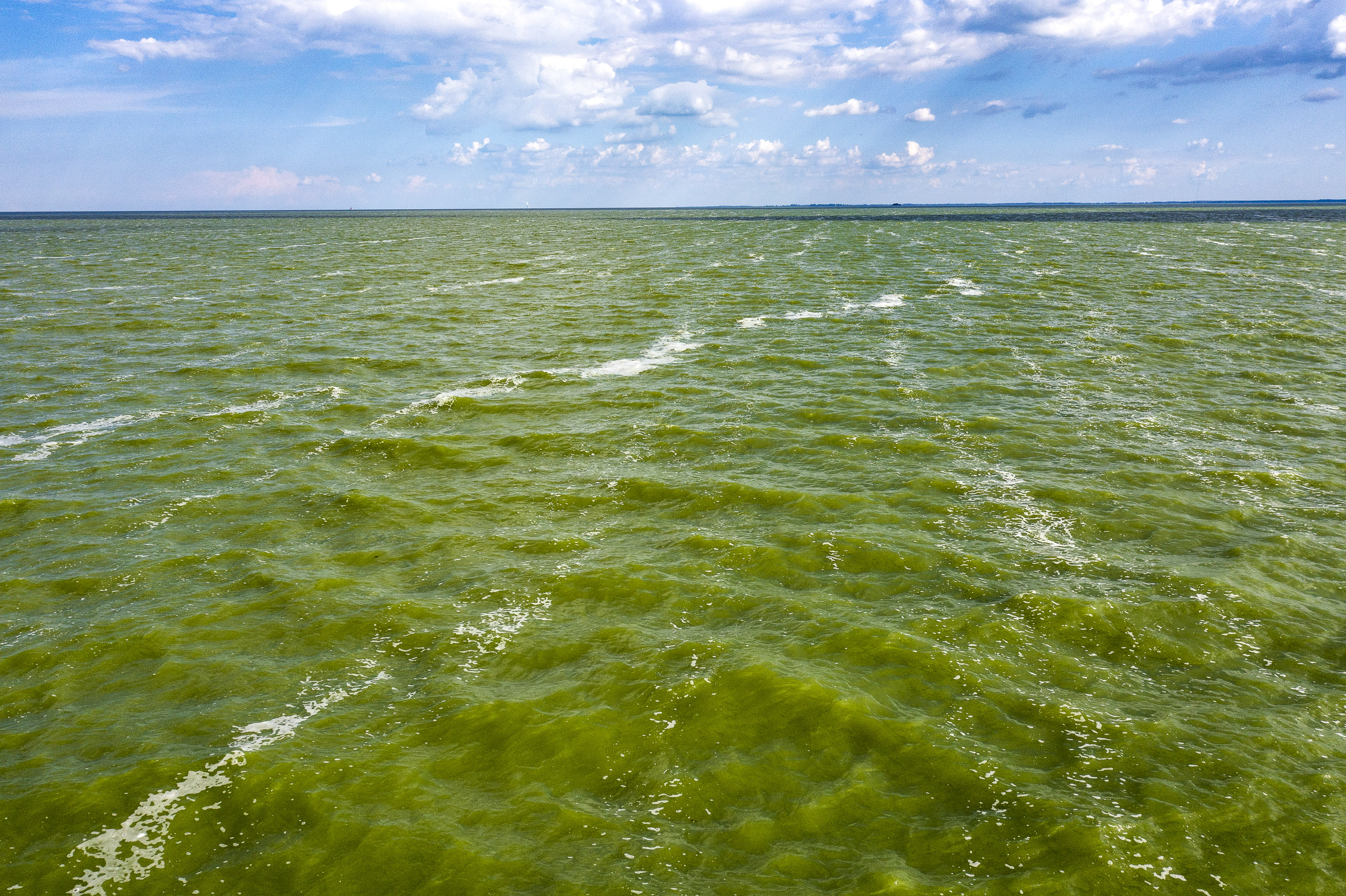
Just as Great Lakes scientists anticipated, the green swirls of a mammoth toxic algae bloom surfaced in the waters of Lake Erie, between Monroe, Michigan, and Toledo, Ohio. Photo © J. Carl Ganter/ Circle of Blue
A National Imperative
Another value of the Great Lakes Water Quality Agreement and the Clean Water Act is that in declaring phosphorus a treacherous pollutant that needs to be stopped, Canada and the U.S. established national imperatives for action. That produced two more responses that achieved measurable results.
The first is the administrative collaboration among two nations, eight states, local governments, academia, and nonprofit groups to raise public awareness and momentum for solutions. The Great Lakes Water Quality Agreement and the Clean Water Act set in motion plausible goals, clear plans of action, regulation, and significant public funding that have produced a large network of governments, communities, universities, foundations, and nonprofits. They behave like the switches and modules of a regional motherboard — communicating, convening, planning, and collaborating on strategies and tools to generate action on harmful blooms.
The second is science. In 1998, as blooms grew bigger and more plentiful, Congress enacted the Harmful Algal Bloom and Hypoxia Research and Control Act to fund research and coordinate the bloom-reducing work by nine federal agencies. In the last decade, according to the National Oceanic and Atmospheric Administration, the U.S. spent roughly $200 million for research that identified the causes of harmful blooms, financed monitoring programs that traced the sources of phosphorus, and yielded technology enabling NOAA to track blooms.
When harmful blooms reappeared in Lake Erie in the late 199os, and grew immense in 2003, the bloom-fighting administrative and scientific infrastructure that was built in the 1990s lumbered into action, albeit at a conventionally sluggish government pace.
In 2012 Canada and the U.S. amended the Great Lakes Water Quality Agreement to include a new goal that called for the Great Lakes to be “free from nutrients that directly or indirectly enter the water as a result of human activity in amounts that promote growth of algae and cyanobacteria that interfere with aquatic ecosystem health, or human use of the ecosystem.”
The two nations committed to develop targets by 2016 for how much phosphorus would be allowed to drain into Lake Erie. Michigan, Ohio, and Ontario agreed to produce action plans to reach them by 2018.
In 2014, the same year that a harmful bloom shut down Toledo’s drinking water plant for three days, the International Joint Commission and the Great Lakes Commission, two agencies that oversee the Water Quality Agreement, called for the phosphorus target in Lake Erie to be cut by 40 percent. A year later the governors of Michigan and Ohio joined the Premier of Ontario in signing the Western Lake Erie Cooperative Agreement. It committed the two states and the Canadian province to reduce the amount of phosphorus flowing into western Lake Erie 20 percent by 2020 and 40 percent by 2025.
Two Michigan governors of different parties embraced the goals.
In 2016, under Republican Gov. Rick Snyder, Michigan formally declared its waters in western Lake Erie “impaired.” That designation made it possible for Michigan to put into effect a program under the Clean Water Act known as a TMDL – total maximum daily load – to set limits for phosphorus draining from Michigan’s six counties of the western Lake Erie basin.
In 2018, the Snyder administration issued its Domestic Action Plan for phosphorus reduction in Lake Erie. The plan noted that Michigan’s total phosphorus load for Lake Erie was 1,883 metric tons a year. To meet the 20 percent by 2020 goal, phosphorus loads would need to be cut 377 metric tons. The plan focused on two strategies. First, it noted that upgrading four wastewater treatment plants on the Detroit River would reduce phosphorus discharges by 252 metric tons.
The authors also focused on promoting best management practices for farmlands and enforcing Michigan’s CAFO permitting system to control nonpoint runoff in Lenawee and the five other western Lake Erie basin counties. The Michigan Department of Agriculture estimated BMPs would reduce phosphorus loadings another 119 metric tons. With upgrades to the Monroe water treatment plant and ending sewer overflows in Detroit, Michigan was poised to meet its 20 percent by 2020 target, which state officials say it has done.
In December 2021, under Democratic Gov. Gretchen Whitmer, three Michigan departments – Environment, Agriculture, and Natural Resources – issued the state’s Adaptive Management Plan to achieve the 40 percent reduction by 2025 goal. It calls for scrubbing 249 more metric tons of phosphorus from agriculture in Michigan’s 1.3 million-acre portion of the western Lake Erie basin.
The annual load of phosphorus in Lake Erie is still close to the 11,000 ton target set in the 1970s. But the mounting challenge is this: dissolved phosphorus, principally from farm runoff, has increased by 132 percent, according to state and federal authorities.
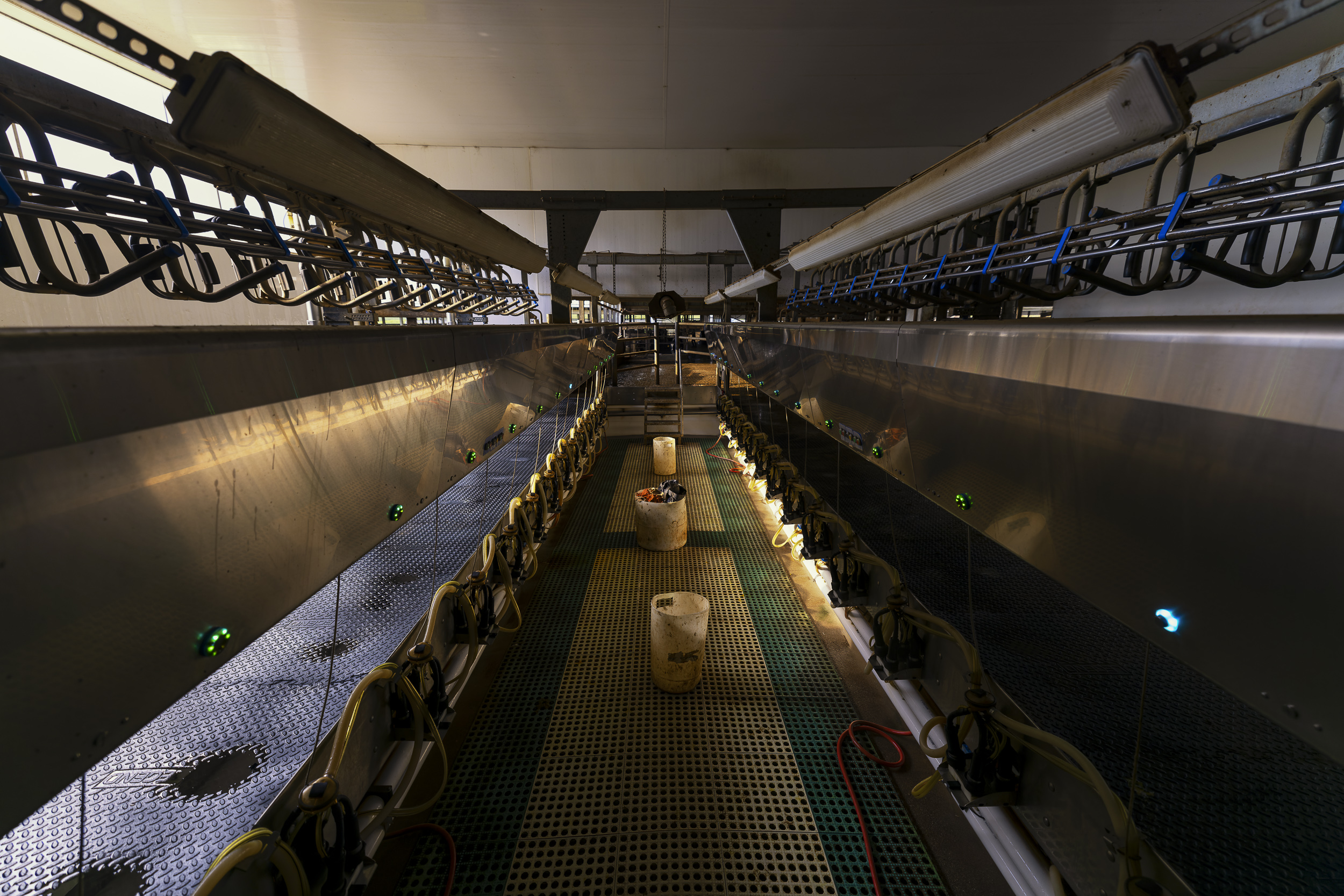
Milking parlor in Lenawee County. Because of their outsize influence in crop and livestock production, altering cultivation and fertilizer practices at big commercial farms is essential for limiting nutrient discharges into ditches and streams. Photo © J. Carl Ganter/ Circle of Blue
Limited Support for Voluntary Changes
Summed up, Tom Van Wagner’s work to convince Lenawee farmers to embrace his phosphorus reduction strategies is not getting any easier. He’s persistent, though. This year Van Wagner is adding a new wrinkle to his campaign to curb farm runoff. He’s recruited Baker and Stutzman and a handful of other farmers to participate in two multi-year projects that call for farmers to not apply any liquid manure or commercial fertilizer on portions of their land, and apply minimal phosphorus at planting — and no more if concentrations in soil are more than 10 parts per million.
The first project will test the idea on 800 acres for five years. The second is aimed at thousands of acres in the Bean Creek watershed. The state Environment Department is providing funding.
The project design is simple and voluntary. Like other conservation programs, Van Wagner offers farmers a financial inducement. Farmers receive a $20 per acre up-front fee. If reduced nutrients result in lower harvests, Van Wagner pays growers a separate per-bushel fee that accounts for the value of any lost yield minus the $140 per-acre savings from not applying commercial fertilizer. For example, if yields in corn are reduced by 10 bushels, and a bushel is priced at $6, that amounts to a loss of $60. The cost of phosphorus fertilizer is about $35 an acre. That farmer’s payment would be $25.00 per acre.
“They’re going to find out they don’t need the nutrients. Their profit is higher without them,” said Van Wagner. “Farmers will save money.”
Limiting nutrient spreading only to farmland with phosphorus concentrations less than 10 parts per million would, if it were embraced across Michigan and the Great Lakes, keep thousands of pounds of the mineral from running into ditches and streams. Much of Lenawee County farmland has higher levels of phosphorus than 10 parts per million.
By recruiting farmers to the project and paying them not to fertilize or spread liquid manure except on soils with scant traces of phosphorus, Van Wagner says he’ll show a 75 percent reduction in phosphorus applications.
Van Wagner and other crop specialists have been making the case for several years that Michigan farmers don’t need to apply as much fertilizer as they generally do. Studies by Michigan State University show phosphorus concentrations in Michigan farmland soils exceed 50 parts per million, quadruple the level of the early 1960s. The 50 ppm level is considered very high for crop production. The university asserts that at least half of state row crop farmland needs no additional phosphorus.
That message penetrated the academic sector. Agronomists at agricultural universities in Indiana, Michigan, and Ohio regularly issue the Tri-State Fertilizer Recommendations, a respected guide for raising corn, wheat, soybeans and other row crops in the three Great Lakes states. In 2020, their recommendations for applying fertilizer dropped sharply. For instance, the recommendation for raising 200 bushels of corn was to apply 70 pounds of phosphorus. That’s less than half the 150 pounds the universities recommended in 1995.
The 2020 Tri-State recommendation for when to apply phosphorus also changed. Fields that contained more than 40 parts per million phosphorus did not need additional nutrients, said the Tri-State report.
The five-year projects, Van Wagner says, will show that farmers can be as profitable, maybe more profitable, because yields are not going to be compromised. “They’ll make an immediate up-front payment. They’ll save money on nutrients. There’s no risk and you’ll get much less running into ditches.”
But Van Wagner’s projects are encountering an impediment that is endemic to all farm conservation programs in Michigan and the Great Lakes states. Not enough farmers want to participate. He estimates that less than 10 percent of Lenawee County’s farmers even embrace best management practices. “Dad runs the farm and still wants to smell that dirt,” Van Wagner said. “They still have the attitude that no-till, no crop.”
Van Wagner recruited 45 Lenawee farmers to undertake his two new projects. Just Stutzman, Baker, and three others agreed to sign up.
Blaine Baker says one reason farmers are reluctant is that conservation programs are temporary by design. With support from the 2018 Farm Bill, he plants cover crops to curb erosion and improve soil health. That practice, too, does not attract many Lenawee farmers.
“It’s ridiculous,” he said. “They were paying $50, $60 an acre for cover crops. It’s probably the most money they made per acre. I know because we can apply cover crops for 25 bucks an acre. So farmers pocketed the money. They make $40 an acre for doing nothing. They’re glad to take the money. But when the money dries up, the program dries up.”
Catch more news at Great Lakes Now:
Farms in Six Southeast Michigan Counties Are Major Sources of Lake Erie Toxic Blooms
Danger Looms Where Toxic Algae Blooms




